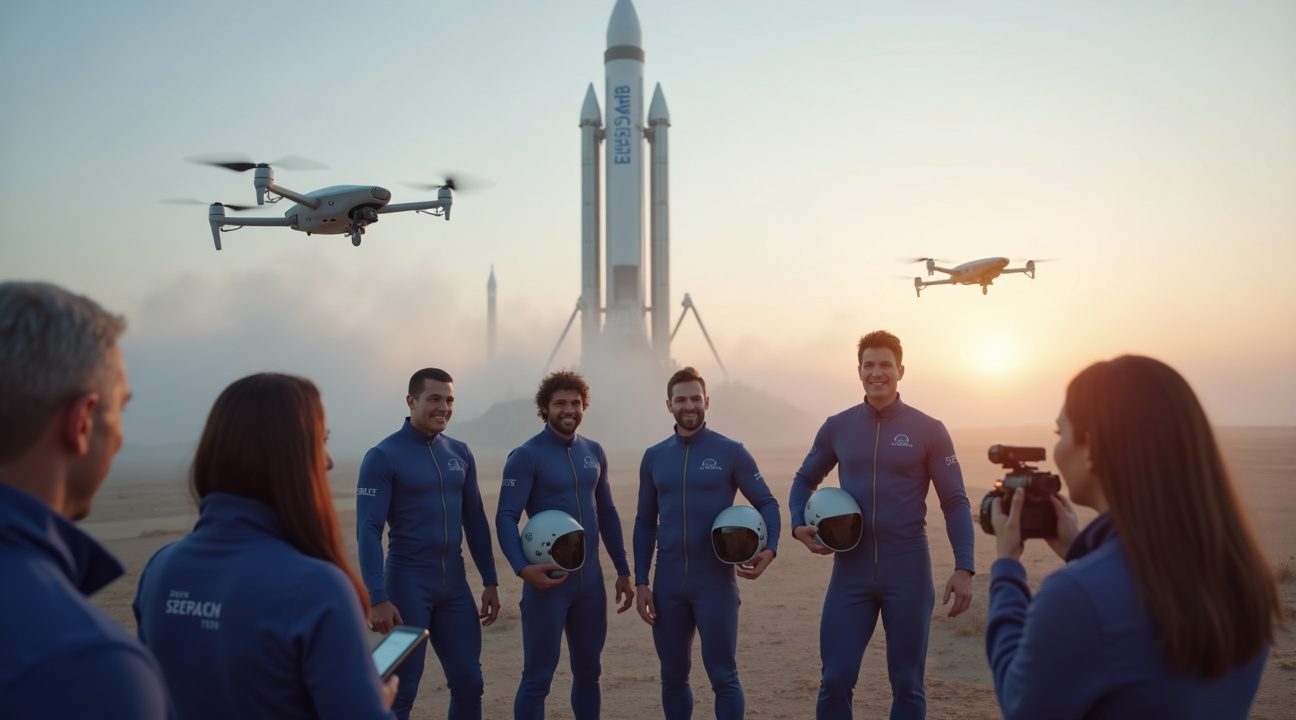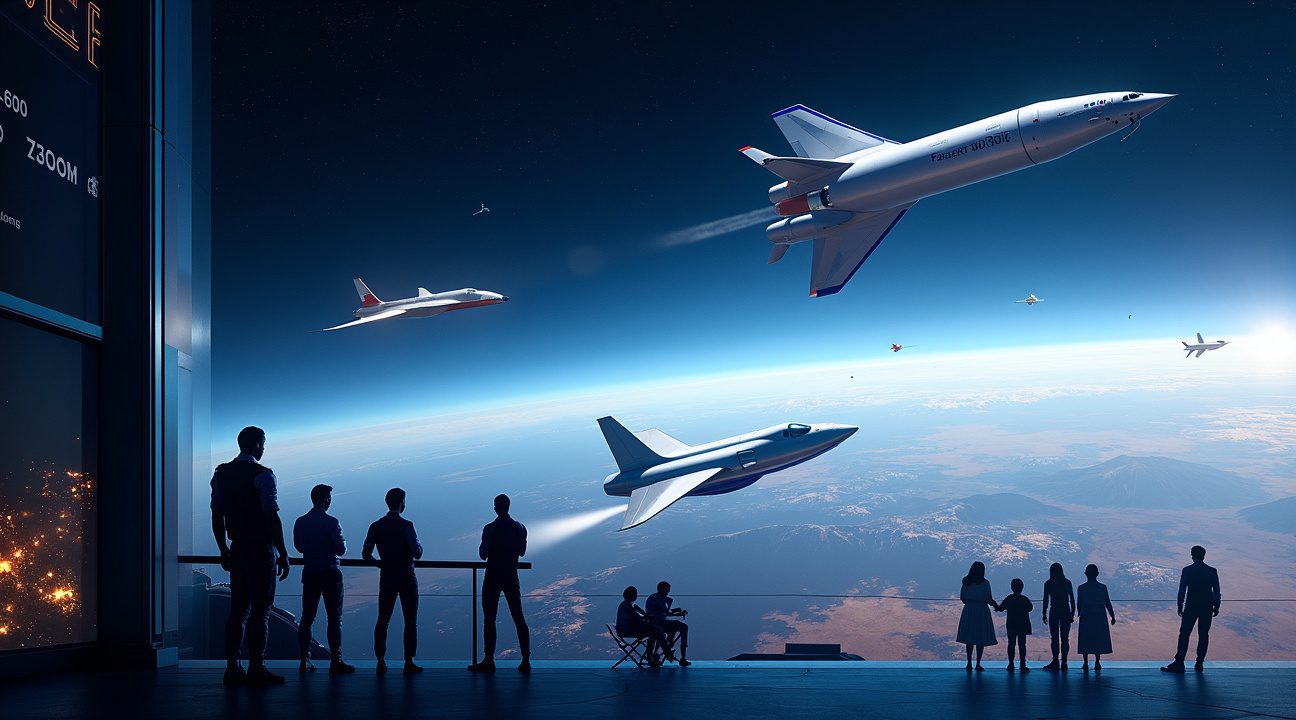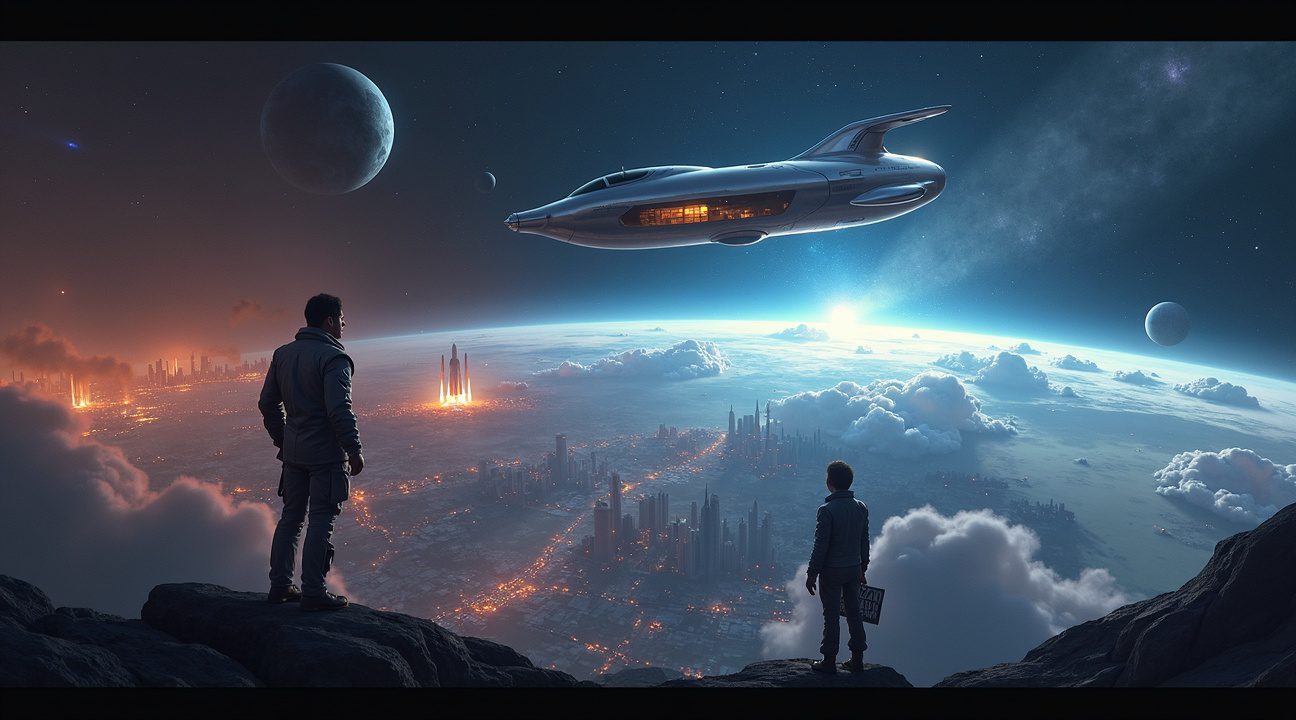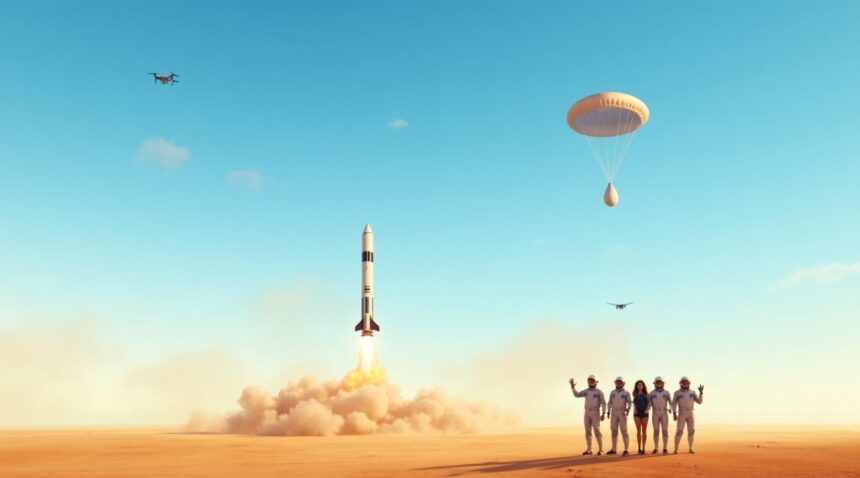Jeff Bezos’s Blue Origin made commercial spaceflight history on October 8, 2025, by deliberately keeping one passenger’s identity secret until after their NS-36 mission concluded—a first for the company that generated widespread speculation throughout the space tourism industry.
Will Lewis: The Mystery Passenger
After much speculation, the enigmatic passenger on the NS-36 flight was revealed to be Will Lewis, CEO of biotechnology firm Insmed. This unconventional strategy of concealing a high-profile flier’s identity paid off by extending public interest and media coverage far beyond the standard pre-launch buildup. It marked a creative evolution in how commercial space tourism missions are promoted.
Key Takeaways
- Blue Origin achieved the first secretive passenger mission in space tourism history, withholding Will Lewis’s identity until after the NS-36 flight concluded.
- The “Space Nomads” crew included professionals from diverse industries, such as biotechnology, franchise management, electrical engineering, media entrepreneurship, software development, and investment sectors.
- The 10-minute suborbital journey soared 66 miles above Earth, passing the Kármán line to offer passengers a brief experience of weightlessness and panoramic views of the planet.
- Blue Origin’s price point of $200,000 to $300,000 per seat positions it as a more economical option than Virgin Galactic’s $600,000 tickets within the expanding market for space tourism.
- Environmental concerns have been raised due to rocket emissions, which are reportedly 500 times more potent at atmospheric warming than other pollution sources, adding urgency to environmental debates around space tourism.
Environmental Impact: A Rising Concern
Despite the excitement surrounding space tourism, environmentalists continue to warn about its ecological footprint. Rocket emissions from such suborbital trips are significantly more harmful than traditional aircraft or industrial emissions, with potential damage to the ozone layer and long-term consequences for atmospheric health. As commercial spaceflights grow in popularity, sustainable innovation will become increasingly critical.
Blue Origin’s First Mystery Passenger Revealed After Historic Flight
Jeff Bezos’s Blue Origin made spaceflight history on October 8, 2025, with its 15th crewed mission, NS-36, but not just for the successful launch. I witnessed something unprecedented in commercial space tourism: the company deliberately kept one passenger’s identity secret until after the flight concluded.
The New Shepard suborbital vehicle carried six passengers on this mission, yet only five names appeared on the pre-flight roster. This intentional secrecy marked a first for Blue Origin, creating significant buzz throughout the space tourism community and media outlets worldwide.
Following the successful completion of the suborbital journey, Blue Origin finally unveiled their mystery traveler: Will Lewis, CEO and chair of biotechnology company Insmed. Lewis’s identity revelation came as a surprise to many industry observers who had spent weeks speculating about the unknown passenger’s background and reasons for maintaining anonymity.
Strategic Marketing Innovation in Space Tourism
Blue Origin’s decision to withhold Lewis’s identity represents a calculated marketing strategy that generated substantial discussion around private spaceflight participation. The approach demonstrated how space tourism companies can create additional media attention and public engagement beyond the typical pre-flight announcements.
This secrecy strategy achieved several key objectives for the company:
- Generated widespread speculation and media coverage leading up to the launch
- Created sustained public interest throughout the flight day
- Extended the news cycle with the post-flight identity reveal
- Established a precedent for future high-profile passenger privacy options
The mystery passenger concept proved particularly effective because it tapped into public curiosity about who might have the resources and desire to experience suborbital flight. Industry analysts noted how this approach could appeal to executives and celebrities who prefer maintaining privacy around their space tourism activities.
Lewis’s background in biotechnology added an interesting dimension to the reveal, as his company Insmed focuses on rare disease treatments. His participation highlights how commercial flights to space continue attracting leaders from diverse industries beyond traditional aerospace sectors.
The NS-36 mission itself proceeded flawlessly, with all six passengers experiencing the standard 11-minute suborbital flight profile that has become Blue Origin’s signature offering. The crew reached the edge of space, experienced several minutes of weightlessness, and enjoyed panoramic views of Earth before returning safely to the West Texas landing site.
This strategic passenger reveal comes at a time when space tourism companies are exploring new ways to differentiate their offerings and maintain public interest. While SpaceX has captured attention with groundbreaking launches and innovative hiring practices, Blue Origin’s mystery passenger approach represents a different angle for generating engagement.
The success of this marketing strategy suggests other space tourism companies might adopt similar approaches for future flights. However, the effectiveness relies heavily on maintaining genuine suspense while ensuring the eventual reveal delivers sufficient intrigue to justify the secrecy.
Lewis’s post-flight comments emphasized his excitement about the experience and his appreciation for Blue Origin’s accommodation of his privacy preferences. His participation demonstrates how space tourism continues expanding beyond early adopters to include established business leaders from various sectors.
The NS-36 mission with its mystery passenger element showcased Blue Origin’s growing confidence in their operational capabilities and marketing sophistication. As the space tourism industry matures, such innovative approaches to passenger engagement and media relations will likely become more common, helping companies maintain public interest in an increasingly competitive market.

Meet the “Space Nomads” Crew Who Made History
The six-member crew of NS-36 adopted the nickname “Space Nomads” to reflect their shared spirit of exploration and adventure. This diverse group represented a fascinating cross-section of entrepreneurs, engineers, and innovators who transformed their passion for space into reality.
Jeff Elgin brought his franchise executive expertise to the mission, while Clint Kelly III contributed his background as an electrical engineer and former DARPA member. Kelly’s participation held special significance as he had previously flown on Blue Origin’s NS-22 in August 2022, making him one of the company’s returning passengers and demonstrating Blue Origin’s growing appeal to repeat participants.
A Diverse Mix of Space Enthusiasts
The crew’s composition showcased the broad appeal of commercial space flights across different industries and backgrounds:
- Danna Karagussova, a media entrepreneur who characterized her participation as both a personal research endeavor and the fulfillment of a lifelong dream
- Aaron Newman, a software entrepreneur and accomplished author bringing his technical perspective to the experience
- Vitalii Ostrovsky, a Ukrainian investor whose presence highlighted the international appeal of space tourism
- Will Lewis, CEO of Insmed and seasoned adventurer who added corporate leadership experience to the group
Karagussova’s approach to the mission proved particularly compelling. She viewed her spaceflight not merely as tourism but as an opportunity to conduct personal research while achieving a goal she’d harbored since childhood. Her perspective reflected the serious scientific curiosity driving many space tourists beyond simple thrill-seeking.
The eclectic mix of entrepreneurial and investment-focused passengers emphasized how space tourism attracts diverse and affluent individuals united by their passion for science, adventure, and technology. Each crew member brought unique expertise and perspectives that enriched the collective experience.
Kelly’s return flight status marked an important milestone for Blue Origin, demonstrating customer satisfaction levels that encourage repeat participation. His willingness to fly again validated the safety and experience quality that modern space exploration companies strive to achieve.
The Space Nomads represented more than just paying passengers. They embodied the entrepreneurial spirit driving the commercial space industry forward, proving that space access continues expanding beyond traditional astronaut programs. Their diverse professional backgrounds created a microcosm of the broader demographic shift occurring as space tourism becomes increasingly accessible to successful professionals across various fields.
Ten Minutes at the Edge of Space: The NS-36 Mission Details
Blue Origin’s NS-36 mission launched from its West Texas facility on October 8, 2025, at precisely 8:40 a.m. local time. I found it fascinating how this brief journey packed an extraordinary experience into just 10 minutes and 21 seconds from liftoff to touchdown.
Flight Profile and Achievements
The spacecraft soared to an impressive altitude of 66 miles (107 kilometers), crossing the internationally recognized Kármán line that marks the official boundary between Earth’s atmosphere and space. Crew members experienced several precious minutes of weightlessness while gazing through large panoramic windows at our planet below. This vantage point offers views that only astronauts and space tourists have witnessed firsthand.
The mission operated completely autonomously, showcasing the sophisticated technology that Blue Origin has developed over years of testing. The New Shepard booster executed a flawless vertical landing back at the launch site, while the crew capsule deployed its parachutes for a gentle descent. Ground crews waited at the landing zone to safely retrieve the passengers, completing another successful demonstration of the company’s operational capabilities.
This flight exemplified everything Blue Origin has built its reputation on: quick but transformative journeys using proven reusable technology. The company has refined this process through numerous unmanned and crewed flights, making space tourism increasingly accessible to civilians rather than just professional astronauts.
The NS-36 mission continues Blue Origin’s momentum in the commercial space industry, where companies like SpaceX have hired young talent to push boundaries. Each successful flight builds confidence in suborbital tourism and demonstrates how private companies are making space travel more routine.
What makes these missions particularly remarkable is their efficiency—passengers experience the ultimate adventure in less time than a typical commute to work. The brief duration doesn’t diminish the impact; those few minutes of weightlessness and the view of Earth’s curvature create memories that last a lifetime. Blue Origin has mastered the art of delivering maximum impact through carefully engineered experiences that prioritize both safety and wonder.
The success of NS-36 adds another milestone to the growing list of achievements in commercial space travel, proving that space exploration continues evolving beyond government agencies into the private sector.
The Price of a Space Dream: Blue Origin vs. Competitors
The cost for a ticket on Blue Origin’s NS-36 mission ranges between $200,000 and $300,000, making it one of the more accessible options in commercial space tourism. Initial flight seat auctions have reached astronomical heights of $28 million, demonstrating the premium some individuals place on experiencing space firsthand.
Comparing Space Tourism Costs
Space tourism competitor Virgin Galactic commands significantly higher pricing at $600,000 per seat, positioning Blue Origin as the more budget-friendly option for aspiring space tourists. These price differences reflect varying approaches to the space tourism market, with each company targeting different segments of wealthy adventurers.
Both companies offer suborbital flights that typically last from 10 to 12 minutes, providing customers with brief yet impactful visits to the edge of space. The experience emphasizes weightlessness and breathtaking views rather than full orbital missions, which would require substantially more time and resources.
The Evolution of Space Tourism Accessibility
Prices have lowered considerably from early space tourism days when participation was far more exclusive and limited to government-trained astronauts or experimental passengers. This shift represents a significant milestone for the industry, as space exploration becomes increasingly commercialized.
Commercial space tourism is slowly expanding its accessibility, though it remains a luxury reserved largely for individuals with significant financial means. The gradual reduction in costs suggests that space tourism may eventually become available to a broader demographic, similar to how commercial aviation evolved from an elite privilege to widespread transportation.
Companies like SpaceX have also entered the space tourism arena, with SpaceX hiring young talent and pushing technological boundaries. The competition between these companies drives innovation and cost reduction, potentially accelerating the timeline for more affordable space travel.
The current pricing structure reflects the enormous costs associated with developing safe, reliable spacecraft and the limited number of flights each company can offer. As technology improves and flight frequency increases, industry experts anticipate that costs will continue declining, making space tourism more accessible to middle-class adventurers within the next decade.
For now, commercial flights to space remain an exclusive experience, but the trajectory suggests that space tourism will follow the same democratization path as other luxury technologies throughout history.
https://www.youtube.com/watch?v=JLFSZ_KN9nE

Growing Criticism of Space Tourism’s Impact
The recent surge in commercial space flights has sparked intense debate about the environmental and social consequences of sending civilians beyond Earth’s atmosphere. While companies like Blue Origin celebrate missions such as NS-36, critics raise serious concerns about the long-term implications of making space travel a luxury commodity.
Environmental and Scientific Concerns
Scientists have identified alarming environmental risks associated with frequent rocket launches. The soot particles emitted by rockets prove up to 500 times more efficient at warming the atmosphere compared to other pollution sources. This stark difference makes even relatively small numbers of launches potentially significant contributors to atmospheric warming.
Environmental experts warn that routine space tourism could undermine decades of progress in ozone layer recovery. The Arctic upper stratosphere faces particular vulnerability to damage from increased rocket emissions. These concerns are especially troubling given the fragile state of our atmospheric protective layers.
Beyond immediate environmental impacts, critics question the scientific value of tourist flights. They argue these missions offer minimal research benefits while consuming substantial resources that could support more meaningful scientific endeavors. The contrast between SpaceX’s exploration missions and tourism flights highlights this tension between scientific advancement and commercial entertainment.
Social Inequality and Ethical Concerns
Social inequality emerges as another major criticism. The exclusive nature of space tourism, with costs reaching hundreds of thousands of dollars, reinforces existing wealth disparities. Critics contend that these flights represent the ultimate luxury purchase, accessible only to society’s most privileged members while pressing earthbound problems remain unsolved.
However, industry supporters present compelling counterarguments. They maintain that commercial spaceflight will eventually democratize space access, similar to how aviation evolved from elite luxury to mass transportation. Proponents argue that today’s expensive tourist flights fund technological innovations that will reduce costs and increase accessibility over time.
Human Experience and Inspirational Value
Participants themselves often defend the value of their experiences. Danna Karagussova and others emphasize the personal transformation and inspirational impact of space travel. They frame these journeys as catalysts for scientific curiosity and technological progress, arguing that the psychological and cultural benefits extend far beyond individual participants.
The space tourism industry points to historical precedents where luxury technologies eventually became mainstream. Early automobiles, computers, and smartphones all began as expensive novelties before becoming widely accessible. Commercial space flights may follow a similar trajectory, supporters argue.
Innovation and Industry Competition
Innovation acceleration represents another key defense of space tourism. Companies investing in civilian space travel drive technological advancement that benefits broader space exploration efforts. The competition between commercial providers creates pressure for safer, more efficient, and cost-effective launch systems.
Public Opinion and Broader Implications
Public opinion remains deeply divided on these issues. Some view space tourism as an inspiring symbol of human achievement and technological progress. Others see it as an egregious display of wealth inequality and environmental irresponsibility. The debate reflects broader tensions about resource allocation, environmental priorities, and social justice in an era of increasing inequality.
The controversy surrounding space tourism exemplifies larger questions about technological progress and its distribution. As young talent enters the space industry, the discussion about space tourism’s role in shaping humanity’s future continues to evolve.
Critics and supporters agree that the industry stands at a crossroads. The choices made today about environmental standards, accessibility, and mission priorities will determine whether space tourism becomes a force for positive change or remains a symbol of exclusive privilege. The ongoing debate reflects society’s struggle to balance technological advancement with environmental responsibility and social equity.
https://www.youtube.com/watch?v=Y3I4cW4vAzw

Sources:
UNILAD – “Blue Origin: Jeff Bezos Secret Space Tourist Revealed”
The Independent – “Blue Origin Mystery Passenger Space”
Space.com – “Blue Origin Space Nomads NS36 Mystery Passenger”
Space.com – “Blue Origin Reveals Space Tourists NS36 New Shepard”
Wikipedia – “Blue Origin”
El Paso Times – “Blue Origin Space Tourists New Shepard Rocket Launch”


